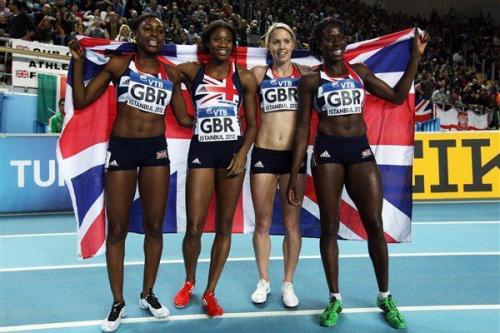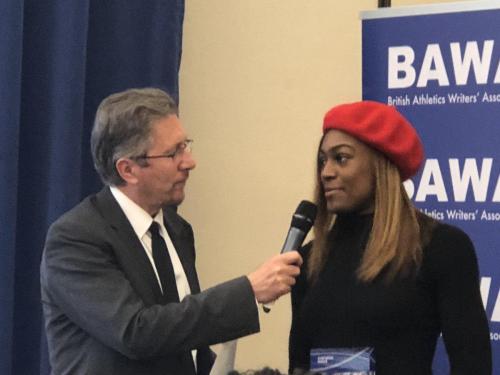 The British 4x400m, in Instanbul 2012, photo by Getty Images / British Athletics
The British 4x400m, in Instanbul 2012, photo by Getty Images / British Athletics
 Geoff Wightman and Perri Shakes Drayton
Geoff Wightman and Perri Shakes Drayton
This is part 2 of the salute to Perri Shakes Drayton, by Stuart Weir. It is a must read.
PSD Part 2
2013-17 was a nightmare for Perri Shakes-Drayton. When she ran the third leg in the 4 by 400 relay heat at the 2017 World Championships, it was 3 days short of four years since her last championship run, the final of the 400H at the 2013 World Championships in Moscow. Having managed to finish that World Championship final in Moscow, albeit 2 seconds slower than her semi-final time, most people did not realize the seriousness of the injury. She saw a specialist in London to hear the life-shattering words that her knee was so badly damaged that she would never hurdle again “I flew home from Moscow”, she recalls, “and saw a surgeon and the UKA doctor who was looking after me, Dr Rob Chakravarty, said: ‘no more hurdles’. I was upset but I said: ‘OK I’ll put that behind me'”.
The next few months were quite traumatic: “To start with I had to be non-weight bearing for three months and at times I was in a wheelchair to make life easier because being on crutches was quite tiring after a while – even though it improved my upper body strength. I had to re-arrange my house and live downstairs because I couldn’t go up the stairs”. I remember seeing her at an awards lunch. She was seated when I arrived and I remember thinking that she looked so glamorous. Then as she shuffled to the front to get her award, she looked like a lady of 90. I had not realized at all the challenges she was facing.
At the 2010 European Championships in Barcelona, Perri had won individual and relay medals. Four years on, it was a different story: “While the 2014 European championship was happening, I went over to the States to work with a physio. I made great progress it was all about balance and trusting the knee, trying to challenge the knee in different directions when it came to balancing. I had to learn to walk again, like a child”. She continued to make progress: “I remember the day that I was able to cycle, when I knew that I was getting full motion in the knee. It was January 2015 before I started to run for the first time. It wasn’t smooth but it was a building block. But as I was making progress something else went wrong with my knee and I had to go back and have surgery. I had a plica removed and got a screw in my knee. That set me back a bit”.
She was still unable to compete at all in 2015 so set her sights on Rio 2016. She ran for the first time in June 2016 – 2 years 9 months after the injury – in a low key race in Germany. She ran 4 races all in 52.something, two seconds slower than in 2013 but that was OK: “I knew it was a process, because when you open up the season – even when you are not injured – you tend to improve, the more races you have. So, I thought: ‘this is OK, it’s the start. I can build from it'”. She ran in the British Championships/Olympic Trials and made the final but did not finish the race.
She recalls: “I tried to make the 2016 Olympics but I picked up another injury, in my hip, and had to have surgery again. So, I missed out on going to the Olympics. That was devastating”. Then her amazing positivity took over again: “I said to myself this injury [hip] is nowhere near as bad as my knee so I can overcome it. I am going to keep going. Until my legs fall off and I am not physically capable of moving or running so I just can’t do it – then I’ll stop”.
She explained to me how the process worked in her mind: “If someone had told me it would take four years to get back to where I needed to be, it probably would have been a different story. I would probably have thought, ‘forget that’ but being the person I am and also all the time I was making progress and I was thinking I’m closer, I’m closer, even though I didn’t feel like myself. I was telling myself: ‘this is how I am going to feel for the rest of my life. My knee is never going to feel the same and I accepted that. So, when I was able to run, I was managing my knee. I thought: ‘OK I can manage it’ and I told myself: ‘for the rest of my life I’m going to have to manage it’. As time went on, I was feeling better and better. My body was getting better and stringer. At every stage I kept feeling better”.
In 2017 the World Championships were in London – not just her home country but her city. In fact she lived pretty close to the Olympic Stadium. But 2017 was a battle. She did not make the team in the individual event but was in the relay squad. She recalls: “I was over the moon to be selected for London 2017 because I didn’t think it would ever happen again. I knew I wasn’t where I had been. I was happy to take the spot for the relay – because I had been doubting whether I would even make trials”. In London 2017, she ran the heat of the relay where GB finished second to USA – as they did in the final when, ironically, without PSD in the team, the time was slower. Shakes-Drayton said of the London 2017 experience: “I loved it, I enjoyed every minute of it, even though it went really fast. I’ve missed being on a world class stage and it felt really good”.
In 2018 was selected by England for the Commonwealth Games in the 4 by 400 meters, finishing fourth and narrowly missing a medal. She failed to make the GB team for the 2018 European Championships or the 2019 World Championships.
Perri Shakes-Drayton was an amazing athlete. Her semi-final on the 400H in the Moscow World Championships, that amazing run to European Indoor Gold and the unbelievable relay leg in Istanbul will live long in my memory. But more than that I will always remember her pleasant demeanour, her willingness to talk after races and her cheerfulness in the midst of all the afflictions in her career in recent years.
Author

Since 2015, Stuart Weir has written for RunBlogRun. He attends about 20 events a year including all most global championships and Diamond Leagues. He enjoys finding the quirky and obscure story.
View all posts




















